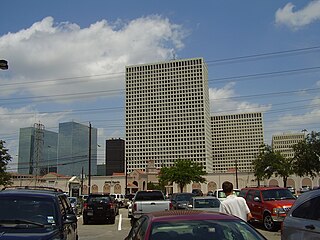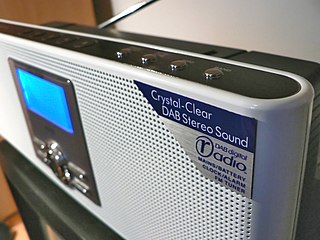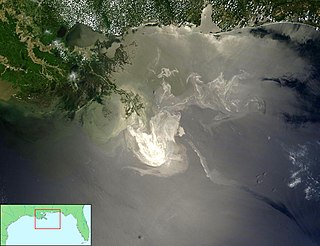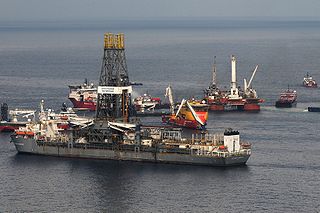
BBC Radio 4 is a radio station owned and operated by the British Broadcasting Corporation (BBC) that broadcasts a wide variety of spoken-word programmes including news, drama, comedy, science and history. It replaced the BBC Home Service in 1967. The station controller is Gwyneth Williams, and the station is part of BBC Radio and the BBC Radio department. The station is broadcast from the BBC's headquarters at Broadcasting House, London. On 21 January 2019 Williams announced she was quitting the role. There are no details of when or who will be her replacement.
Halliburton Company is an American multinational corporation. One of the world's largest oil field service companies, it has operations in more than 70 countries. It owns hundreds of subsidiaries, affiliates, branches, brands, and divisions worldwide and employs approximately 55,000 people.

The Democratic Alliance for the Betterment and Progress of Hong Kong is a pro-Beijing conservative political party established in 1992 in Hong Kong. Chaired by Starry Lee, it is currently the largest party in the Legislative Council and the District Councils, commanding 13 seats and 118 seats respectively.

Transocean Ltd. is the world's largest offshore drilling contractor and is based in Vernier, Switzerland. The company has offices in 20 countries, including Switzerland, Canada, United States, Norway, Scotland, India, Brazil, Singapore, Indonesia and Malaysia.

Pensacola Bay is a bay located in the northwestern part of Florida, United States, known as the Florida Panhandle.

Reliance Petroleum Limited is a company owned by Reliance Industries Limited (RIL), one of India's largest private sector companies. It is based in Ahmedabad, Gujarat, India and has interests in the downstream oil business. RPL also benefits from a strategic alliance with Chevron India Holdings Private Limited (Singapore), a wholly owned subsidiary of Chevron Corporation USA (Chevron), which currently holds a 5% equity stake in the Company.

In the United Kingdom, the roll-out of digital radio is proceeding since engineering test transmissions were started by the BBC in 1990 followed by a public launch in September 1995. The UK currently has the world's biggest digital radio network, with 103 transmitters, three national DAB ensembles and 48 local and regional DAB ensembles broadcasting over 250 commercial and 34 BBC radio stations across the UK. In the capital, London there are already more than 64 different digital stations available. In addition to DAB and DAB+, radio stations are also broadcast on digital television platform as well as internet radio in the UK. Digital radio ensemble operators and stations need a broadcasting licence from the UK's media regulator Ofcom to broadcast.

Deepwater Horizon was an ultra-deepwater, dynamically positioned, semi-submersible offshore drilling rig owned by Transocean. Built in 2001 in South Korea by Hyundai Heavy Industries, the rig was commissioned by R&B Falcon, registered in Majuro, and leased to BP from 2001 until September 2013. In September 2009, the rig drilled the deepest oil well in history at a vertical depth of 35,050 ft (10,683 m) and measured depth of 35,055 ft (10,685 m) in the Tiber Oil Field at Keathley Canyon block 102, approximately 250 miles (400 km) southeast of Houston, in 4,132 feet (1,259 m) of water.
Deepwater Millennium is a fifth generation Samsung/Reading & Bates designed, dynamic positioned (DP) Marshall Islands-flagged drillship owned by Transocean. The vessel is capable of drilling in water depths up to 8,100 ft using an 18.75 in (47.6 cm), 15,000 psi blowout preventer (BOP), and a 21 in (53 cm) outside diameter (OD) marine riser.

The Mississippi Canyon is an undersea canyon, part of the Mississippi Submarine Valley in the North-central Gulf of Mexico, south of Louisiana. According to the U.S. Geological Survey GLORIA Mapping Program, it is the dominant feature of the north-central Gulf of Mexico. According to GCAGS Transactions, it has an average width of 8 kilometres (5.0 mi), and a length of 120 kilometres (75 mi). The US Minerals Management Service (MMS) applies the name Mississippi Canyon to numbered federal oil and gas lease blocks over a large offshore area centered on, but mostly outside, the submarine canyon.

Deepwater Wind is an off-shore wind energy development group that built the Block Island Wind Farm in Rhode Island, United States.

The Tiber Oil Field is a deepwater offshore oil field located in the Keathley Canyon block 102 of the United States sector of the Gulf of Mexico. The deepwater field was discovered in September 2009 and it is operated by BP. Described as a "giant" find, it is estimated to contain 4 to 6 billion barrels of oil in place. Although BP states it is too early to be sure of the size – a "huge" field is usually considered to contain 250 million barrels. It required the drilling of a 10,685 m (35,056 ft) deep well under 1,260 m (4,130 ft) of water, making it one of the deepest wells ever drilled at the time of discovery.
A contourite is a sedimentary deposit commonly formed on continental rise to lower slope settings, although they may occur anywhere that is below storm wave base. Countourites are produced by thermohaline-induced deepwater bottom currents and may be influenced by wind or tidal forces. The geomorphology of contourite deposits is mainly influenced by the deepwater bottom-current velocity, sediment supply, and seafloor topography.
The velvet catshark is a deepwater catshark. It is known only from a single specimen collected off the Tanimbar Islands in the Arafura Sea, Indonesia, at a 840–855 m depth. The only known specimen, a juvenile male, measured a total of 36 cm in length.

The Deepwater Horizon oil spill is an industrial disaster that began on April 20, 2010, in the Gulf of Mexico on the BP-operated Macondo Prospect, considered to be the largest marine oil spill in the history of the petroleum industry and estimated to be 8% to 31% larger in volume than the previous largest, the Ixtoc I oil spill, also in the Gulf of Mexico. The U.S. government estimated the total discharge at 4.9 million barrels. After several failed efforts to contain the flow, the well was declared sealed on September 19, 2010. Reports in early 2012 indicated that the well site was still leaking.

The Macondo Prospect is an oil and gas prospect in the United States Exclusive Economic Zone of the Gulf of Mexico, off the coast of Louisiana. The prospect was the site of the Deepwater Horizon drilling rig explosion in April 2010 that led to a major oil spill in the region.

The Deepwater Horizon drilling rig explosion was the April 20, 2010, explosion and subsequent fire on the Deepwater Horizon semi-submersible Mobile Offshore Drilling Unit (MODU), which was owned and operated by Transocean and drilling for BP in the Macondo Prospect oil field about 40 miles (60 km) southeast off the Louisiana coast. The explosion and subsequent fire resulted in the sinking of the Deepwater Horizon and the deaths of 11 workers; 17 others were injured. The same blowout that caused the explosion also caused a massive offshore oil spill in the Gulf of Mexico, considered the largest accidental marine oil spill in the world, and the largest environmental disaster in U.S. history.

Discoverer Enterprise is a fifth generation deepwater double hulled dynamically positioned drillship owned and operated by Transocean Offshore Deepwater Drilling Inc., capable of operating in moderate environments and water depths up to 3,049 m (10,000 ft) using an 18.75 in (47.6 cm), 15,000 psi blowout preventer (BOP), and a 21 in (53 cm) outside diameter (OD) marine riser. From 1998 to 2005 the vessel was Panama-flagged and currently flies the flag of convenience of the Marshall Islands.

Block Island Wind Farm is the first commercial offshore wind farm in the United States, located 3.8 miles (6.1 km) from Block Island, Rhode Island in the Atlantic Ocean. The five-turbine, 30 MW project was developed by Deepwater Wind. Construction began in 2015 and in late summer 2016 five Alstom Haliade 150-6-MW turbines were erected. Operations were launched in December 2016. It is the largest project using wind power in Rhode Island.
















